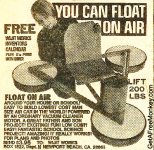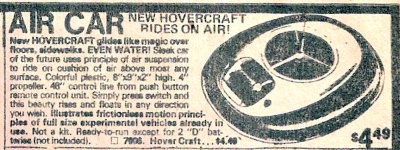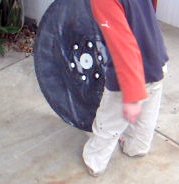
Thomas Tilley
[ Home ] [ Publications ] [ Resume ] [ Family ] [ Projects ] [ The Others ] [ Sitemap ]

[ Home ] [ Publications ] [ Resume ] [ Family ] [ Projects ] [ The Others ] [ Sitemap ]
 Source: Get a Free Monkey |
 Source: Whitechapel |
We were living in Melbourne, Australia in 2005 and once a year in Melbourne something wonderful happens - something wonderful called "hard rubbish collection". People put any items that are too big to fit in their normal weekly rubbish collection out on the side of the road and then contractors come along and collect them. For about a week the streets are suddenly filled with old lounges, broken TV sets, faulty washing machines, wheel-less bicycles and old vacuum cleaners. That's right - vacuum cleaners. Inspired by the sight of old vacuum cleaners I decided that it was time to try and fulfill one of my life-long ambitions. I was finally going to build a hovercraft.

Armed with this set of plans from the internet I scavenged three vacuum cleaners (the motor on one of them still worked) and three sheets of wood from the street and set to work.
Vacuum cleaners normally suck but we needed something that blew air to provide lift for our hovercraft so some modification was going to be required. I stripped the case from the working vacuum cleaner and then cut a hole in the end of the plastic motor cover. Using some polystyrene foam and duct tape I then redirected the normal airflow so that it blew out through the new hole in the bottom instead. I also repositioned the on/off switch and wrapped any exposed wiring with electrical tape.
In addition to the parts that I had already scavenged the plans also called for the plastic lid from a coffee tin (the lid from a can of tennis balls or potatoe chips would also suffice), a single nut and bolt, and some black polythene sheeting. Although the plans suggested using a 4 foot (approximately 122cm) plywood disc for the base the largest piece of chipboard that we had found was only big enough for us to cut into a circle with a radius of 90cm (approximately 3 feet). I also cut a hole halfway between the center of the circle and the outer rim that provided a snug fit for the lift motor.

The skirt of the hovercraft was constructed by covering the underside of the disc with black polythene sheeting. The original plans suggested using staples to secure the plastic but for want of a staple gun we duct taped the sheeting to the top of the disc which we further reinforced with some foil nails like those in the diagram on the right.
The plastic coffee tin lid was bolted underneath the center of the disc and six evenly spaced holes cut around it. These holes were also reinforced with duct tape. The plastic lid holds the skirt in close at the center of the disc so that when inflated it forms a doughnut-like shape under the hovercraft. The holes around the lid allow air to escape out from the "doughnut hole" and underneath the edges of the skirt so that the disc floats on a cushion of air. The diagram below summarises the hovercraft's construction with red arrows representing the air flow:
I'm not sure whose idea it was but after moving our kitchen table and conducting a brief test-run on the floor we thought it might be fun to let our son ride the hovercraft down the sloping driveway. You can see the hovercraft in action here:
Unsurprisingly, he accelerated quickly down the slope. Fortunately, my wife pulled the plug on the power cord, the skirt deflated, and with a little help from the cameraman the hovercraft ground to a halt, stopping only about a metre and a half from the closed gate at the bottom of the driveway! He had previously done something similar on his skateboard but on that occasion the gate was open. You may notice that in both videos not only are the location and the music the same but so are my son's clothes! This was obviously his favourite attire at the time.
In addition to the instructions we used you can now find many links with information about DIY hovercrafts. Even Adam and Jamie built some "levitation machines" which they raced during an episode of MythBusters.
You may also be interested in reading about the Dance Dance Revolution (DDR) mat we made using the rest of our scavenged wood or some of my other projects: